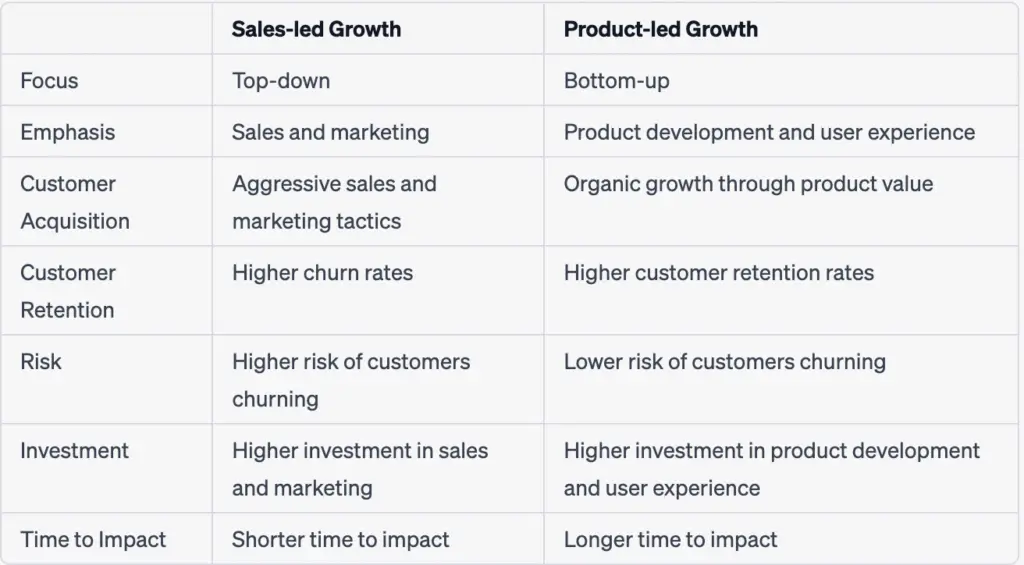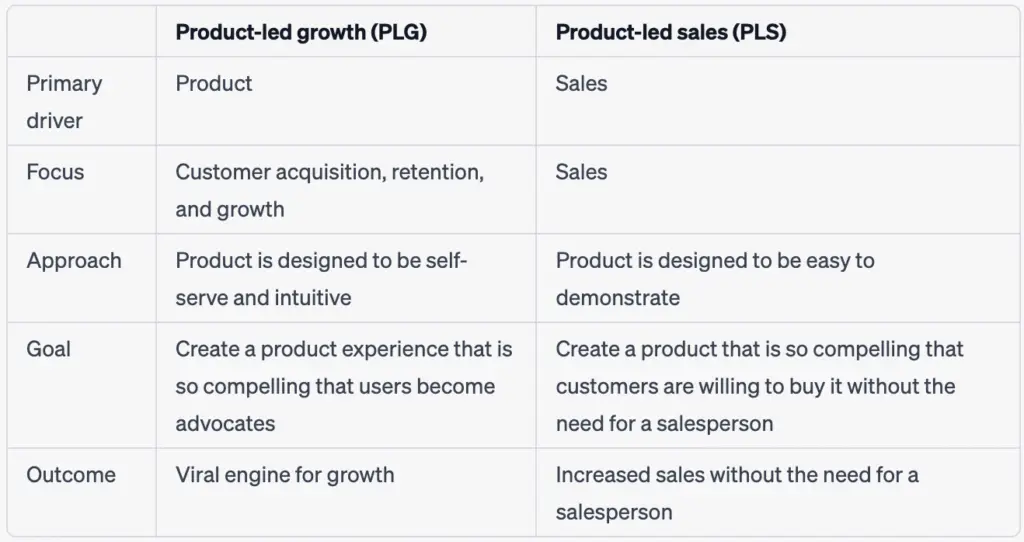Product-Led Growth: The Ultimate Guide to Supercharge Your Business Growth
If you are an entrepreneur or business owner, you may have heard about product-led growth. It has become a popular buzzword in the business world, but what is it? How does it work? And why is it important for your business?
In this article, we’ll dive deep into the concept of product-led growth and show you how it can supercharge your business growth.
What is Product-Led Growth?
The term “product-led growth” was originally stated in 2016 by Blake Bartlett at OpenView, and it’s the secret behind successful companies like Atlassian, Dropbox, and Slack.
Product-led growth (PLG) is a business strategy that focuses on creating a product that is so good that it drives growth through user acquisition, retention, and expansion. The product itself becomes the main driver of business growth, rather than relying on sales and marketing efforts.
PLG is a customer-centric approach to growth. The goal is to create a product that customers love and can’t live without. By doing so, the product becomes the best marketing tool for the business. Satisfied customers become loyal customers and will recommend the product to others.
Why is Product-Led Growth Important?
Product-led growth is important because it is a more sustainable and scalable way to grow a business. Traditional growth strategies rely on sales and marketing efforts to acquire and retain customers. This approach can be expensive and is not always effective. In contrast, PLG leverages the power of the product to drive growth.
PLG also creates a better customer experience. By focusing on the product, businesses can create a seamless and intuitive user experience that keeps customers coming back for more. The product becomes a solution to the customer’s problem, rather than just a product for sale.
How Does Product-Led Growth Work?
Product-led growth works by focusing on three stages: acquisition, activation, and retention. Let’s explore each of these stages in more detail.
Acquisition
The first stage of PLG is acquisition. This stage focuses on getting new users to try the product. The goal is to create a product that is so compelling that users are willing to sign up and give it a try.
To achieve this, businesses need to create a free trial experience that is easy to use and showcases the value of the product. This can include features such as guided tours, onboarding emails, and in-app tutorials.
Activation
The second stage of PLG is activation. This stage focuses on getting users to experience the full value of the product. The goal is to create a product that is so good that users can’t live without it.
To achieve this, businesses need to focus on user onboarding. This can include features such as personalized onboarding, in-app messaging, and customer support. The goal is to help users understand how to use the product and get the most value out of it.
Retention
The third stage of PLG is retention. This stage focuses on keeping users engaged with the product over time. The goal is to create a product that users love and can’t live without.
To achieve this, businesses need to collect data and analyze metrics to understand how users are using the product. This can include features such as usage analytics, customer feedback surveys, and in-app messaging to encourage continued engagement with the product.
Understanding the Three Stages of Product-Led Growth
To understand product-led growth, it’s essential to break it down into the three stages of acquisition, activation, and retention.
Acquisition is the first stage of product-led growth. It focuses on getting new users to try the product. This stage is critical because it sets the foundation for the rest of the growth process. If the acquisition stage is not successful, the rest of the growth process will be compromised.
Activation is the second stage of product-led growth. It focuses on getting users to experience the full value of the product. This stage is critical because it determines whether users will continue to use the product or not.
Retention is the third stage of product-led growth. It focuses on keeping users engaged with the product over time. This stage is critical because it determines whether users will continue to use the product and refer it to others or not.
Step-by-Step Guide to Implementing Product-Led Growth
Now that we understand the three stages of product-led growth, let’s explore a step-by-step guide to implementing PLG in your business.
Step 1: Define Your Ideal Customer Profile
The first step in implementing PLG is to define your ideal customer profile. This involves understanding who your target audience is and what their pain points and needs are. By understanding your target audience, you can create a product that addresses their specific needs and pain points.
Step 2: Develop a Free Trial Experience
The second step in implementing PLG is to develop a free trial experience. This involves creating a free trial that showcases the value of your product and makes it easy for users to try it out.
To create a successful free trial experience, you need to focus on the user experience. This can include features such as guided tours, onboarding emails, and in-app tutorials.
Step 3: Focus on User Onboarding
The third step in implementing PLG is to focus on user onboarding. This involves helping users understand how to use the product and get the most value out of it.
To create a successful onboarding experience, you need to focus on personalization. This can include features such as personalized onboarding, in-app messaging, and customer support.
Step 4: Collect Data and Analyze Metrics
The fourth step in implementing PLG is to collect data and analyze metrics. This involves understanding how users are using your product and identifying areas for improvement.
To collect data and analyze metrics, you need to focus on usage analytics, customer feedback surveys, and in-app messaging. By understanding how users are using your product, you can make data-driven decisions that improve the user experience and drive growth.
Advantages of Product-Led Growth
There are several advantages to implementing product-led growth in your business. These include:
- Lower customer acquisition costs: By focusing on the product, businesses can reduce their customer acquisition costs. Customers who love the product are more likely to recommend it to others, reducing the need for expensive marketing campaigns.
- Increased customer retention: By creating a product that customers love, businesses can increase customer retention. Satisfied customers are more likely to continue using the product and referring it to others.
- Better customer experience: By focusing on the product, businesses can create a better customer experience. A seamless and intuitive user experience keeps customers coming back for more.
- Scalable growth: Product-led growth is a more sustainable and scalable way to grow a business. The product becomes the main driver of growth, reducing the need for expensive sales and marketing efforts.
Disadvantages of Product-Led Growth
There are also some disadvantages to implementing product-led growth in your business. These include:
- Time-consuming: Implementing product-led growth requires a significant investment of time and resources. It can take months or even years to develop a product that truly resonates with customers and drives growth.
- Risky: Product-led growth is a risky approach because it relies heavily on the success of the product. If the product doesn’t resonate with customers or fails to deliver value, the entire growth strategy can fall apart.
- Limited applicability: Product-led growth is best suited for businesses that have a product that can be easily tried and tested. For businesses that offer complex services or products that require a significant investment, product-led growth may not be as effective.
- Requires a shift in mindset: Implementing product-led growth requires a shift in mindset from traditional sales and marketing tactics. Businesses need to focus on creating a product that delivers value to customers rather than relying on aggressive sales and marketing tactics.
10 PLG Tools to drive growth
Product-led growth (PLG) is a strategy that relies on the product itself to drive customer acquisition, retention, and growth. There are many different tools available that can help businesses implement a product-led growth strategy. Here are 10 PLG tools that businesses can use to drive growth:
- Userpilot – a product experience platform that helps businesses optimize their onboarding and user engagement.
- Appcues – a product experience platform that helps businesses create in-app experiences and user guides to improve customer engagement and retention.
- Amplitude – a product analytics platform that helps businesses analyze user behavior and identify opportunities for growth.
- Intercom – a customer messaging platform that helps businesses communicate with their customers in a personalized and scalable way.
- Mixpanel – a product analytics platform that helps businesses analyze user behavior and track product metrics.
- Hotjar – a user experience platform that helps businesses understand how their users interact with their product and identify opportunities for improvement.
- FullStory – a customer experience platform that helps businesses analyze customer behavior and identify areas for improvement.
- Pendo – a product experience platform that helps businesses improve their onboarding, feature adoption, and customer feedback.
- UserVoice – a customer feedback platform that helps businesses collect and analyze customer feedback to improve their product.
- WalkMe – a digital adoption platform that helps businesses create personalized and interactive user experiences to improve customer engagement and retention.
These PLG tools can help businesses create a seamless and intuitive product experience, increase customer engagement, and drive growth in a sustainable and scalable way.
Results
A product-led growth model may not be the best fit for your business at this time.
#1. Is your product easy to use without the need for extensive training or support?
Product-led growth vs Sales-led growth
Product-led growth and sales-led growth are two different approaches to achieving growth in a business.
Sales-led growth is the more traditional approach, where businesses focus on aggressive sales and marketing tactics to acquire and retain customers.
This approach is typically more top-down, with a heavy emphasis on the sales team’s efforts to drive revenue.
Product-led growth, on the other hand, is a more bottom-up approach that focuses on creating a product that delivers value to customers, leading to organic growth and increased customer retention. This approach is more user-centric and places a higher emphasis on the product team’s efforts to drive growth.
Here is a tabular comparison of the two approaches:

Overall, while sales-led growth can be effective in the short term, it often leads to higher churn rates and a more transactional relationship with customers. Product-led growth, on the other hand, requires a significant investment in product development and user experience, but can lead to more sustainable and scalable growth over time.
Difference between product-led growth and product-led sales
Product-led growth (PLG) and product-led sales (PLS) are two different approaches to growing a business, although they are related. PLG is a strategy that relies on the product itself to drive customer acquisition, retention, and growth, while PLS is a sales strategy that relies on the product to sell itself through features and benefits.
In a PLG strategy, the product is the primary driver of growth. This means that the product is designed to be self-serve, intuitive, and easy to use, with features and benefits that encourage users to share it with others. The goal is to create a product experience that is so compelling that users become advocates, and the product itself becomes a viral engine for growth.
In contrast, PLS is a sales strategy that relies on the product to sell itself through features and benefits. This means that the product is designed to be easy to demonstrate, with features and benefits that are clearly communicated to potential customers. The goal is to create a product that is so compelling that customers are willing to buy it without the need for a salesperson to persuade them.
Here’s a table that summarizes the differences between PLG and PLS:

Overall, while both PLG and PLS rely on the product to drive growth, the focus and approach of each strategy are different. PLG is focused on creating a product experience that is so compelling that it becomes a viral engine for growth, while PLS is focused on creating a product that is so compelling that customers are willing to buy it without the need for a salesperson.
Related Posts
Conclusion
Product-led growth is a powerful strategy for businesses looking to drive growth in a sustainable and scalable way.
By focusing on the product and creating a seamless and intuitive user experience, businesses can reduce customer acquisition costs, increase customer retention, and create a better overall customer experience.
However, implementing product-led growth requires a significant investment of time and resources and can be risky for businesses that rely heavily on traditional sales and marketing tactics.
Overall, product-led growth is a valuable strategy for businesses that have a product that can be easily tried and tested and are willing to shift their mindset from traditional sales and marketing tactics to a product-first approach.




















